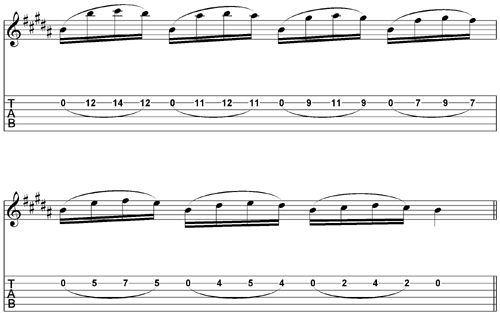In this lesson I am going to show you how to expand on the concept we discussed in Open String Flash Licks, Part 1 to create even flashier sounding (yet easy to play) licks. Then I am going to teach you an additional concept that I use quite often to create less predictable sounding licks and runs.
As with Part 1, I am demonstrating this concept using the Lydian Mode in the key of E, but you should experiment with using this concept with other modes as well as the Pentatonic Scale.
You will get the greatest benefit from this (as with all of my lessons) by using the concepts or ideas discussed to generate your own licks in different keys and with various scales.
Ready? Then let's get ripping!
Example 1. Here I have taken the 3-note pattern from our last lesson and expanded it into a 4-note lick. I am demonstrating this lick moving down the neck, but you should practice this moving up as well.

Pretty cool stuff right? I really like the sound of this type of lick. It's easy to play it quickly too!
If you would like to receive a free E Lydian jam track to practice along with, email me.
Here is a fun idea you can apply to this and (of course) other licks you play. I call it "Paul's Twisted Rule Of Threes." (Note: it's not really a rule, just a silly name I gave it.)
I got the idea from the typical 3-note sequences most guitarists play.
This may seem complicated at first, but please bear with me and I'll help you to understand.
A typical 3-note sequence a guitarist might use to play a one octave C Major (or any) Scale would go like this: "CDE - DEF - EFG - FGA - GAB - ABC".
So in essence what you are doing when playing this 3-note sequence is:
I was pondering this one day and thought, "What if I used this same sort of idea to sequence through little sections of the fretboard or modules rather than just a straight scale?"
Now I imagine right about now many of you are scratching your head and saying "Huh?!"
The easiest way to help you to understand this concept is to just show you the lick. Then, go back and read the above explanation and it should make more sense to you. Trust me, it is worth taking the time to understand this. Remember when I told you to bear with me?
Example 2. This is simply Example 1 with my "Twisted Rule Of Threes" concept applied.
img class="column-text-img" src="/images/columns/columnist603b.jpg" alt="pic" />
Notice how in measure one we played the first three groupings of the lick, move back one position, do three groupings from there, and then repeat the process.
You can receive exclusive free guitar lessons and other guitar playing resources directly from me by signing up for my free guitar lesson newsletter here.
I hope you have enjoyed this lesson. Experiment with applying this concept to different scales and keys. If you have any questions on this lesson, or have a particular topic you would like to see covered in a future lesson, email me.
So, what's in store for us next time? Stay tuned to find out! Happy jamming and thank you for your interest!
Paul Tauterouff is a professional musician and guitar teacher in upstate New York.
His CD "Audio Chocolate" sold for many years on the Guitar Nine site.